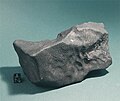Bassikounou (meteorite)
Coordinates: 15 ° 47 ′ 0 ″ N , 5 ° 54 ′ 0 ″ W.
Location in Mauritania |
Bassikounou is an observed meteorite fall from October 16, 2006 from southeastern Mauritania . Bassikounou is the ninth meteorite and the third observed fall in Mauritania. At the same time, it is the best-documented meteorite fall in the Sahara state .
Meteorite fall
After a spectacular fireball phenomenon lasting more than 30 seconds at 4:00 am, at least 102 fragments ranging in size from 2 g to 6 kg fell 11-18 km north and south-east of Bassikounou. Several eyewitnesses said they heard prolonged thunder and rustling in the air. The impact of some fragments of the meteorite near a nomad camp near Oum Sdeira was also heard by the Bedouins camping there. Panic broke out in some places in the fall area.
The first meteorites were recovered in the early morning of October 16, including a 3,165 g individual. A patrol of the Mauritanian military stationed on the nearby border with Mali visited the fall area on the morning of October 16 and confiscated some of the meteorites found by the population. The military then carried out their own search, which led to further finds.
The 3165 g mass was brought to Germany by a family member of the finder and finally in December / January 2007 at the University of Bern in Switzerland by a team led by Dr. B. Hofmann analyzed and classified. The meteorite was published in Meteoritical Bulletin 92 (2007).
Classification
Bassikounou is an olivine bronzine chondrite of type H5 with a shock grade S2 and a weathering grade of W0. The measurement of short-lived cosmogenic radionuclides at the University of Neuchâtel confirmed a recent fall date. The meteorite has a light matrix with fine anthracite-colored shock veins and a matt black fine-grained enamel crust. Further features are isolated larger NiFe concretions in the crust and matrix, which can reach dimensions of up to 1 cm.
Although the event was spread across the country through a press release from the Mauritanian state news agency, newspaper reports on October 25 and radio reports, the news of this new case did not reach Europe until the spring of 2007. At that time, it was also assumed that it was a single stone weighing 3165 g. When further stones from the fall appeared in Morocco, the German meteorite scientists Svend Buhl and Matthias Baermann began to collect eyewitness reports, find reports, maps and background information via a Mauritanian correspondent in Nouakchott. The results of this research have been available in the form of a report since June 2007.
literature
- Chute d'un corps lumineux . In: Horizons, Nouakchott, October 25, 2006, p. 1 and 6th
- Svend Buhl, Matthias Baermann: The Bassikounou Meteorite Fall, Descriptive Catalog of the Recovered Masses , Vol. 1, Hamburg 2007.
Web links
- "A Star Fell Down At Bassikounou", Svend Buhl & Matthias Baermann. Illustrated case report and taxonomic catalog of the recovered masses
- Catalog and image index of the recovered meteorites from the Bassikounou fall (PDF file; 4.88 MB)
- Meteoritical Bulletin 92 (2007) with the publication on the Bassikounou meteorite (p. 1648) (PDF file; 421 kB)



